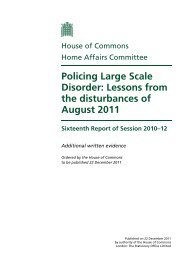Murder and Serious Sexual Assault - Lancaster EPrints - Lancaster ...
Murder and Serious Sexual Assault - Lancaster EPrints - Lancaster ...
Murder and Serious Sexual Assault - Lancaster EPrints - Lancaster ...
You also want an ePaper? Increase the reach of your titles
YUMPU automatically turns print PDFs into web optimized ePapers that Google loves.
INTRODUCTION<br />
Many individuals who are present on the OI have been convicted of only a single<br />
offence <strong>and</strong> a high proportion of these will have desisted from crime. The<br />
comparison group was therefore chosen to be made up of active but less serious<br />
offenders. In this context, an active offender was one who had been convicted of an<br />
offence in the same calendar year as the serious offender (the index conviction).<br />
For murder cases, control individuals were selected who had not been convicted for<br />
any offence relating to murder (that is, murder, manslaughter, infanticide, attempted<br />
murder or threats to kill) at the index conviction. Additionally, like the case, the<br />
control should also not have been convicted for murder in their previous criminal<br />
history. Control group cases with previous convictions for other offences relating to<br />
murder (i.e. manslaughter, infanticide, attempted murder or threats to kill) were,<br />
however, included.<br />
In a similar way, the relevant control group offender for a SSA case was an active<br />
offender who had not committed a serious sexual offence as their index offence. This<br />
definition excluded offenders with a conviction for any type of rape (including<br />
attempts) of males or females of any age, indecent assault against females aged 16 or<br />
over who received any length of custodial sentence, all indecent assault against females<br />
under 16, other serious sexual offences against children or males, or incest. The offence<br />
of murder was also excluded. Offenders were additionally excluded from the control<br />
group on the basis of the following previous convictions: murder; (completed) rape of a<br />
female of any age; indecent assault of a female under 16; <strong>and</strong> indecent assault of a<br />
female aged 16 or over who received any length of custodial sentence.<br />
Those convicted of indecent assault of a female aged 16 or over who received<br />
shorter custodial sentences (that is, not reaching the thresholds defining a ‘serious’<br />
offence identified in Appendix A), were neither used as cases nor controls. This was<br />
to allow some leeway in the definition of what separates a serious indecent assault of<br />
an adult female from a less serious indecent assault. However, those previously<br />
convicted of indecent assault of an adult female who did not receive a custodial<br />
sentence were available as cases or controls. This issue becomes particularly<br />
important in the analyses that follow.<br />
Control groups can produce misleading results. For example, if a control group of<br />
offenders not convicted of murder reveals that previous violence offences are a risk<br />
factor for murder, it is unclear whether the risk factor is specific to murder or<br />
represents a general risk factor for any serious violent conviction (of which murder<br />
is the extreme example). The control group, after all, is likely to be dominated by<br />
5
















